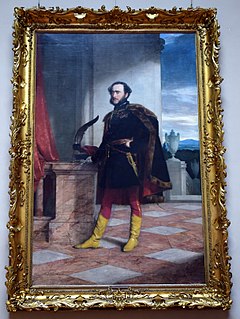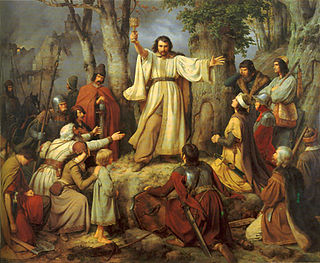 W
WCharles I Insulted by Cromwell's Soldiers is an oil painting by the French artist Paul Delaroche, depicting Charles I of England taunted by the victorious soldiers of Oliver Cromwell after the Second English Civil War, prior to his execution in 1649. Completed in 1836, it is thought to be one of Delaroche's greatest masterpieces. It was displayed as part of the Bridgewater Collection in London, although it was latterly thought to have been lost when, during The Blitz of 1941, a German bomb struck close to Bridgewater House, causing shrapnel damage to the canvas in the ensuing explosion. In 2009 it was rediscovered in Scotland in an unexpectedly good condition, having been rolled up and stored after the war, but recorded in the intervening years as badly damaged or destroyed. After a partial restoration it went on display in the National Gallery in London, in an exhibition re-appraising Delaroche's work. After the exhibition, it is to be fully restored.
 W
WCinq-Mars Handing his Sword to Louis XIII is a c.1836-1837 painting by Claudius Jacquand. It is now held at the Royal Monastery of Brou, though it also appeared in the 2014 exhibition L'invention du passé. Histoires de cœur et d'épée en Europe, 1802-1850.
 W
WCinq-Mars' Farewell to Marie d'Entraigues or The Kiss Goodbye is a painting by Claude Jacquand in 1836, which is kept at the Musée des beaux-arts de Lyon.
 W
WThe portrait of Count István Széchenyi is a monumental painting by Austrian painter Friedrich von Amerling. It belongs to the Art Collection of the Hungarian Academy of Sciences in Budapest, where it portrays the founder of the institution. It has the same elaborate Rococo frame as the contemporary painting of From Darkness, the Light by Johann Ender. The painting is probably the most famous portrait of Széchenyi, the greatest statesman of the Hungarian Reform Era.
 W
WCows Crossing a Ford is an early 19th century painting by French artist Jules Dupré. Done in oil on canvas, the work depicts farmers driving their cattle across a river in Limousin, a region of central France. The way in which the low horizon and sky are rendered in the painting are a testament to Dupré's interest in the works of John Constable and Richard Parkes Bonington, two landscape painters. Cows Crossing a Ford is in the collection of the Metropolitan Museum of Art.
 W
WAn Episode from the Russian Campaign is an 1836 oil on canvas painting by Nicolas-Toussaint Charlet, now in the Musée des Beaux-Arts de Lyon. It shows the retreat from Moscow in 1812 at the end of the French invasion of Russia.
 W
WThe Family of Mr. Westfal in the Conservatory is an early 19th-century painting by German artist Eduard Gaertner. Done is oil on canvas, the painting depicts a conservancy owned by Christian Carl Westphal (de) and his family. A wealthy Berlin merchant known for his love of horticulture, Westphal was also Gaertner's landlord. The small painting is one of only four interior scenes painted by Gaertner. It was acquired by the Metropolitan Museum of Art in 2007, and remains in the museum's collection.
 W
WThe Greeks and the Trojans Fighting over the Body of Patroclus is an oil painting by Antoine Wiertz. Several versions of the painting exist. The first was made in year 1836.
 W
WThe Hussite Sermon is a painting by the Düsseldorf-based painter Carl Friedrich Lessing, showing an open-air sermon being delivered by a Hussite preacher in the 15th century. It is now in the Alte Nationalgalerie in Berlin.
 W
WThe Lion in Love is an 1836 oil on canvas painting in the Academic-Romantic style by Camille Roqueplan (1800–1855) now in the Wallace Collection in London.
 W
WMignon desires her fatherland is an 1836 painting by the Dutch-French artist Ary Scheffer. The picture depicts a young woman Mignon, inspired from a character in Goethe's 1795-96 novel Wilhelm Meister's Apprenticeship. The 1866 Ambroise Thomas opera Mignon was based on the same character, and Scheffer's feminine representation of Mignon in a dress influenced her portrayal by Thomas. The painting currently hangs in the Dordrechts Museum in Dordrecht, Netherlands.
 W
WView from Mount Holyoke, Northampton, Massachusetts, after a Thunderstorm, commonly known as The Oxbow, is a seminal landscape painting by Thomas Cole, founder of the Hudson River School. The painting depicts a Romantic panorama of the Connecticut River Valley just after a thunderstorm. It has been interpreted as a confrontation between wilderness and civilization.
 W
WPortrait of Maria Antonietta of Tuscany is an 1836 oil on canvas painting by Giuseppe Bezzuoli, now in the Gallery of Modern Art in Florence. Shown aged 22, its subject is Maria Antonia, grand-duchess of Tuscany and second wife of Leopold II. In the left background is Palazzo Vecchio and the city of Florence, with a sunset and a dog in tribute to Antony van Dyck and Titian. His use of colour shows the influence of Ingres and there are some stylistic similarities to the work of Francesco Hayez.